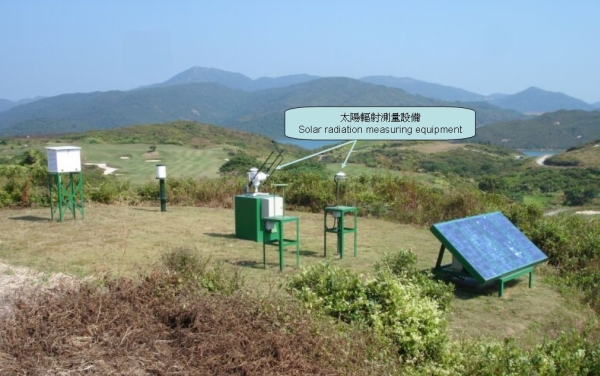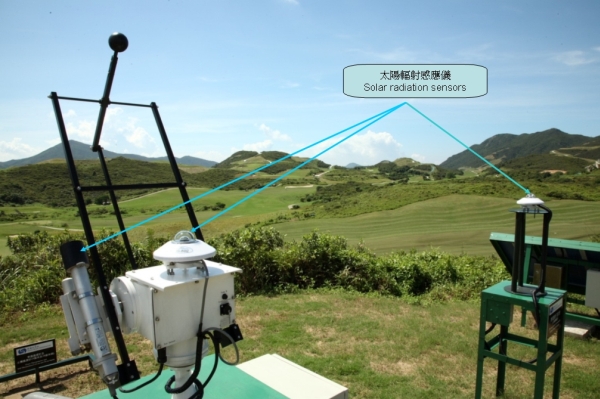Radiation Tidbits - Solar radiation
Written by: Yeung Siu-wai
The term "Radiation" is sometimes referred to as Ionizing Radiation. Generally speaking, radiation also includes electromagnetic waves corresponding to different energy spectrums. This article explains a kind of radiation from outer space - solar radiation.
- What is solar radiation?
- What are the effects of solar radiation to the earth?
- What are the effects of the Earth's atmosphere to solar radiation?
- How does the Observatory measure solar radiation?
- What is solar radiation?
Solar radiation refers to the electromagnetic waves continuously emitted by the Sun, and carries with it solar energy. The Sun emits electromagnetic waves in a wide range of wavelengths, and its energy is carried mainly in the form of ultraviolet ray, visible light and infrared ray. Most solar energy comes from visible light and infrared ray. Only a very small part is in the form of ultraviolet ray. When passing through the Earth's atmosphere, solar energy is largely attenuated and only a very small part reaches the Earth's surface. Nevertheless, this small amount of solar energy is crucial to the Earth's ecological development.
- What are the effects of solar radiation to the earth?
Solar radiation brings light and heat to the earth, providing a favourable environment for the growth of living things.
The intensity of solar radiation reaching the Earth's atmosphere depends on the Sun's elevation angle, distance between the Sun and the Earth as well as the duration of sunshine. In general, radiation intensity is higher at noon than in the morning and at night; in summer than in winter; and in low latitudes than in high latitudes. Due to the uneven distribution of solar radiation intensity on the Earth, solar heating is not balanced in different regions which causes the atmospheric motions. Atmospheric circulation transfers heat and moisture from one region of the Earth to another region, between high and low latitudes as well as land and sea. It advances the balance of the Earth's heat and water. It also induces various kinds of weather and climate in various places.
As a result of geological movement over many years, plants and animals in ancient times slowly deposited on seabed or underground after death. Under high temperature and pressure, the dead bodies underwent biological and chemical changes and broke down into organic matters, and eventually turned into coal, oil, natural gas and other fuels. Through such process, solar energy is gradually conserved and turned into the Earth's resources.
Overly intense solar radiation has an adverse effect to the growth of plants and animals on the Earth. Exposure to strong ultraviolet radiation will lead to sunburn. When we are on high ground with snow-covered surface or sunny days, we should take adequate protective measures against sunburn arising from ultraviolet radiation.
- What are the effects of the Earth's atmosphere to solar radiation?
The Earth's atmosphere will attenuate solar radiation. The intensity of solar radiation reaching the Earth's surface, after passing through the atmosphere, will be subject to the following factors :
- absorption: water and carbon dioxide in the air absorb infrared radiation, ozone absorbs ultraviolet radiation.
- scattering: air molecules, dust, cloud droplets change the direction of radiation, such that less solar radiation can reach the ground.
- reflection: part of the solar radiation is reflected back into the space by clouds and dust.
Solar radiation successfully passing through the atmosphere without scattering and reaching the ground is called direct radiation; the radiation arriving on the ground through scattering or reflecting by the atmosphere is called diffuse radiation. Total solar radiation refers to the sum of direct and diffuse radiation of the Sun.
- How does the Observatory measure solar radiation?
The Hong Kong Observatory has been measuring solar radiation at the King's Park Meteorological Station since 1959. In view of the gradual impact of neighboring high-rise buildings to the station, the Observatory established a new solar radiation station at Kau Sai Chau in 2008. Sensors were deployed there for long-term observation of solar radiation. Solar radiation data can be very useful in weather and climate research as well as architectural and engineering design. The real-time data can be accessible via the Observatory's website.


Kau Sai Chau Solar Radiation Station
 Back to Top
Back to Top